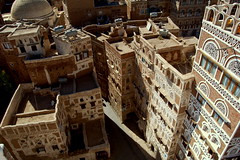Late Antique Yemen
On the heels of the last post, I was entranced by this lush travel article in the New York Times (free registration required) about the Yemeni island of Socotra, off the Horn of Africa. It's not difficult to imagine traders on that Alexandria-India run porting here for one last pit stop before the big push across the Arabian Sea:
Soon after, Abraha, one of the generals Kaleb left behind to manage the occupation, seized power and broke off from Abyssinia, but he overextended himself with an attempt to conquer more of the Arabian peninsula in 552. In 570, Sayf ibn dhi-Yaz'an, a Yemenite Jewish aristocrat, appealed to Sassanid Persia to oust the Christians. The Sassanids, who were engaged in their seemingly neverending struggle with the Byzantine Empire, were happy for any opportunity to widen their sphere of influence. They promptly sent troops, displaced what was left of Abyssinian rule, and installed a governor. In 632, as the forces of Muhammad were conquering what would become the Islamic empire, the last Persian governor of Yemen threw his support to them. Once the most powerful state on the Arabian peninsula, Yemen was unceremoniously subsumed by the first caliphate and declined into a backwater.
Sayf ibn dhi-Yaz'an's gambit was nominally successful, in the long run. Under Islamic rule, Yemenite Judaism enjoyed a resurgence that lasted until the 19th century, but Christianity was virtually wiped out on mainland Yemen. The gilded cathedral in the Himyarite capital of Sana'a (still the capital of Yemen today), built by Abraha to demonstrate his power and attract Christian converts from wandering Arab tribes, was destroyed in the 8th century. Some of its bricks and columns are part of the modern city's great mosque.
Out on Socotra, among the frankincense trees, Islam did not come with Muhammad. Yemenite Christianity on Socotra managed to hang on until the 16th century, when Islam finally hitched a ride to the island via Portuguese traders in the Indian Ocean.
Socotra is significantly inhabited, and has been for some 2,000 years. More than 40,000 people now live there: many in Hadibu, the island’s main town, the rest scattered in small stone villages, working as fishermen and semi-nomadic Bedouin herders. Nature and culture are longstanding neighbors.I especially liked this bit:
Lying on the rocky ground, with the scent of frankincense fresh in memory, I felt as though I had stumbled into a chapter of the Old Testament. Well before dawn I woke to the sound of the family patriarch’s voice warbling a long, mournful prayer. He finished after a few minutes, and the night closed over the sound. I listened awhile longer to the holy darkness, then fell again to sleep.Mainland Yemen was a player on the Late Antique geopolitical scene. Throughout most of antiquity, the region was politically fragmented among several small kingdoms, but by 300 it had been unified under the mountainous western kingdom of Himyar. Himyarite rule lasted until 525, when the Jewish ruler incurred the wrath of the Christian kingdom of Abyssinia (roughly, modern Ethiopia). The Abyyssinian king, Kaleb, converted the Himyarites to Christianity at sword-point and placed a puppet on the throne.
Soon after, Abraha, one of the generals Kaleb left behind to manage the occupation, seized power and broke off from Abyssinia, but he overextended himself with an attempt to conquer more of the Arabian peninsula in 552. In 570, Sayf ibn dhi-Yaz'an, a Yemenite Jewish aristocrat, appealed to Sassanid Persia to oust the Christians. The Sassanids, who were engaged in their seemingly neverending struggle with the Byzantine Empire, were happy for any opportunity to widen their sphere of influence. They promptly sent troops, displaced what was left of Abyssinian rule, and installed a governor. In 632, as the forces of Muhammad were conquering what would become the Islamic empire, the last Persian governor of Yemen threw his support to them. Once the most powerful state on the Arabian peninsula, Yemen was unceremoniously subsumed by the first caliphate and declined into a backwater.
Sayf ibn dhi-Yaz'an's gambit was nominally successful, in the long run. Under Islamic rule, Yemenite Judaism enjoyed a resurgence that lasted until the 19th century, but Christianity was virtually wiped out on mainland Yemen. The gilded cathedral in the Himyarite capital of Sana'a (still the capital of Yemen today), built by Abraha to demonstrate his power and attract Christian converts from wandering Arab tribes, was destroyed in the 8th century. Some of its bricks and columns are part of the modern city's great mosque.
Out on Socotra, among the frankincense trees, Islam did not come with Muhammad. Yemenite Christianity on Socotra managed to hang on until the 16th century, when Islam finally hitched a ride to the island via Portuguese traders in the Indian Ocean.


Comments
Judith
Visit Zenobia's new blog Empress of the East
The contentious point is the date of the Himyarite conquest of South Arabia: if it had been accomplished by the end of the first C AD (generally accepted, they vanquished Saba in 25 BC, Qataban in 50 AD, and Hadramaut in 100 AD), what, then, was the status of the five Hadramaut kings who left the hundreds of texts inscribed on boulders near Shabwa? Still independent? Or vassals of Himyar?
The Palmyran connection: One of the texts, now dated to 235 AD, mentions the presence of Tadmarite (Palmyran) guests at the installation of the king (along with Babylonians and Indians as well as Himyarites). Vassals or not, this text confirms an existing relationship between the Tadmarites and S. Arabian rulers in the third C.
In turn, this provides an historical basis for the (otherwise anachronistic) report in the Historia Augusta that 'Arabs from Arabia Felix' were paraded among the captives in Aurelian's triumph.
Does this help, or further confuse the issue? I'm not sure :-)
Judith
Visit Zenobia's new blog at Empress of the East